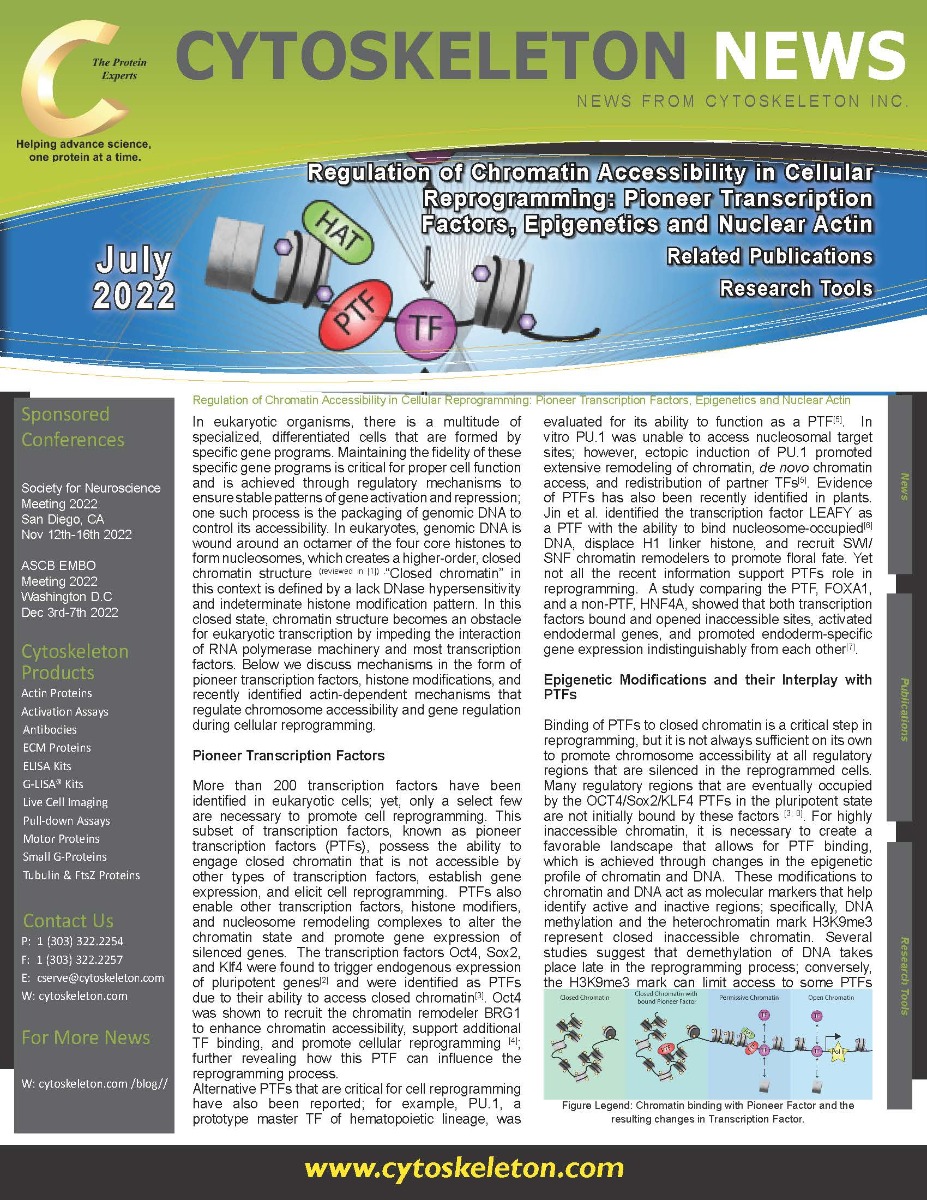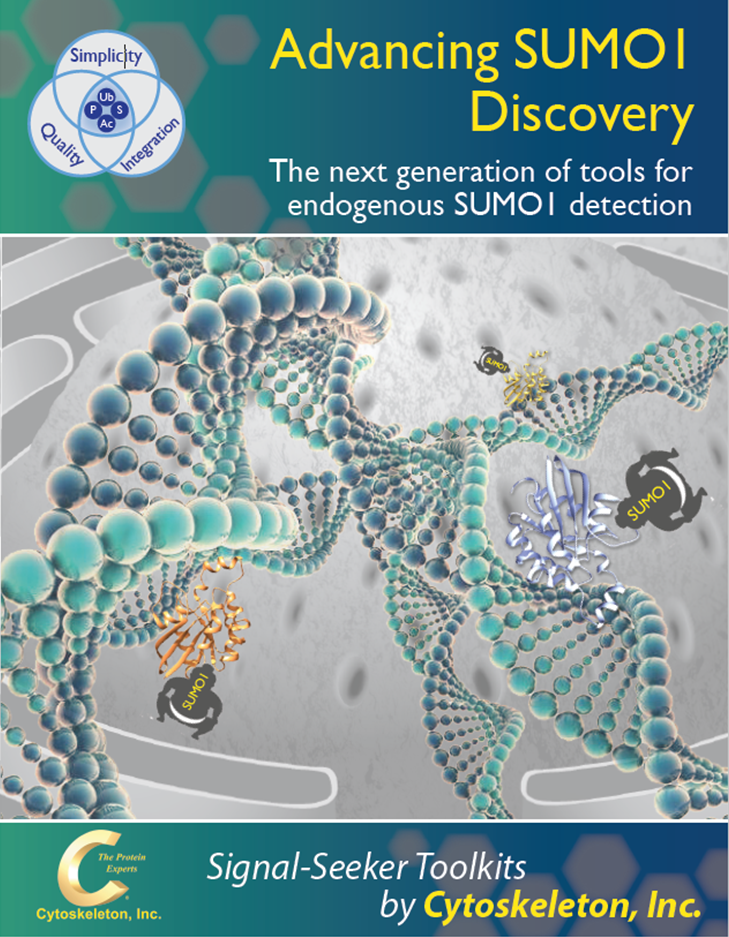Signal Seeker PTM Information
Although there are over 200 types of PTMs described in the literature, there are only a handful that have been studied in great detail, of these serine/threonine phosphorylation, tyrosine phosphorylation (pY), acetylation (Ac), ubiquitination (Ub) and SUMOylation (SUMO) have been shown to be key regulators in almost all cellular processes, including signal transduction, epigenetics, gene and protein expression, protein stability and localization, and cellular immunity. Learn more about these key regulatory protein modifications and the Signal-Seeker™ tools used to study them by clicking on the options below.
Learn More About Post Translational Modifications
Our most recent Actin writings can be found below. However Cytoskeleton has been writing about Post Translational Modifications for years, and that library of information can be found here
Regulation Of Chromatin Accessibility In Cellular Reprogramming: Pioneer Transcription Factors, Epigenetics And Nuclear Actin
In eukaryotic organisms, there is a multitude of specialized, differentiated cells that are formed by specific gene programs. Maintaining the fidelity of these specific gene programs is critical for proper cell function and is achieved through regulatory mechanisms to ensure stable patterns of gene activation and repression; one such process is the packaging of genomic DNA to control its accessibility. In eukaryotes, genomic DNA is wound around an octamer of the four core histones to form nucleosomes, which creates a higher-order, closed chromatin structure
Controlling Ubiquitination is Key in the War on Bacteria
Ubiquitination is a well-studied post-translational modification (PTM) that regulates a multitude of cellular events through its well-established role of targeting proteins for degradation via the proteasome. More recently, the ubiquitin (Ub) machinery has been shown to play a key role in targeting organelles such as mitochondria and endoplasmic reticulum for recycling in cooperation with the autophagic machinery. However, the Ub system does not only regulate the host-cell’s protein turnover; rather, increasing evidence shows that it plays a key role in the cells defense against invading bacterial pathogens
Signal-Seeker™ Tools In Action - Citation Spotlights
Degradation Of CCNK/CDK12 Is A Druggable Vulnerability Of Colorectal Cancer
O2-Dependent Protein Internalization Underlies Astrocytic Sensing Of Acute Hypoxia By Restricting Multimodal TRPA1 Channel Responses
Novel therapies are needed to combat cancer cells that acquire resistance to current treatments, as well as, to find more efficacious drugs with defined mechanisms and better therapeutic windows. Dieter et al. sought to identify a novel treatment for colorectal cancer (CRC); utilizing an array of techniques and validation models they identified NCT02 as a novel therapeutic that specifically treated a subset of CRCs. To achieve their goal, an 80,000 small molecule library screen was tested against patient-derived CRC spheroids. After multiple rounds of validation and selective screening, 14 compounds were chosen for additional testing. These compounds were analyzed against eight different tumor spheroid cultures as well as primary fibroblasts, the result was NCT02 being identified as a suitable drug that targeted a subset of CRCs while lacking activity against primary fibroblasts.
Oxygen, which is critical for ATP generation in aerobic organisms, is essential for life; conversely deprivation of oxygen, hypoxia, results in impaired cell signaling, energy crisis, and ultimately demise. Specific organs of the body have much higher consumption of O2 such as the central nervous system (CNS) which has high energy demands. Recently, Uchiyama et al. investigated the mechanisms by which neuronal cells regulate and respond to O2 deprivation and determined that a sensor cation channel transient receptor potential (TRP) A1 in pFRG/RTN astrocytes are critical for responding to hypoxic conditions. Interestingly, they determined that under normoxic conditions TRPA1 undergoes proline hydroxylation and internalization from the plasma membrane.
Please visit our product pages for product specific citations
Ubiquitination Detection Kit - Acetyl-Lysine Detection Kit - SUMOylation 2/3 Detection Kit
Cytoskeleton's line of Signal-Seeker Tools
Browe Cytoskeleton Inc's selection of tools by clicking the brochure above, or the button below which will take you to a category page which you can navigate to see our full selection of Acetyl Lysine Tools.
Tyrosine Phosphorylation Tools Brochure
Browe Cytoskeleton Inc's selection of tools by clicking the brochure above, or the button below which will take you to a category page which you can navigate to see our full selection of Tyrosine Phosphorylation Tools.
Browe Cytoskeleton Inc's selection of tools by clicking the brochure above, or the button below which will take you to a category page which you can navigate to see our full selection of SUMOylation 1 Tools.
SUMOylation 2/3 Tools Brochure
Browe Cytoskeleton Inc's selection of tools by clicking the brochure above, or the button below which will take you to a category page which you can navigate to see our full selection of SUMOylation 2/3 Tools.
Browe Cytoskeleton Inc's selection of tools by clicking the brochure above, or the button below which will take you to a category page which you can navigate to see our full selection of Actin Tools.
Have a technical question about our tools? Send us an email at tservice@cytoskeleton.com and our experts will anwser any question you may have!









